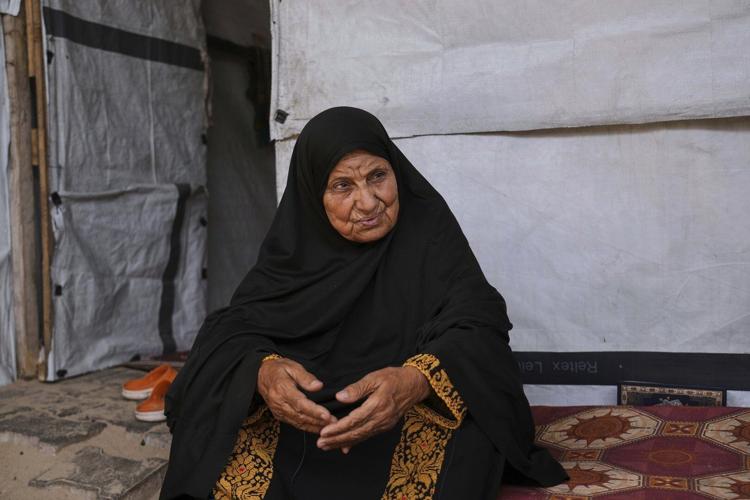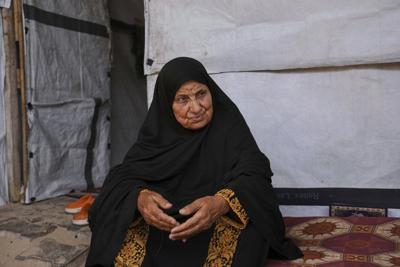KHAN YOUNIS, Gaza Strip (AP) â As a 4-year-old, Ghalia Abu Moteir was driven to live in a tent in Khan Younis after her family fled their home in whatâs now Israel, escaping advancing Israeli forces. Seventy-seven years later, she is now back in a tent under the bombardment of Israelâs campaign in Gaza.
On Thursday, Palestinians across the Middle East commemorated the anniversary of the âNakbaâ — Arabic for âthe Catastropheâ — when some 700,000 Palestinians were expelled by Israeli forces or fled their homes in what is now Israel before and during the 1948 war that surrounded its creation.
Abu Moteirâs life traces the arc of Palestiniansâ exile and displacement from that war to the current one. has flattened much of Gaza, killed more than 53,000 people, driven almost the entire population of 2.3 million from their homes and threatens to push them into .
âToday weâre in a bigger Nakba than the Nakba that we saw before,â the 81-year-old Abu Moteir said, speaking outside the tent where she lives with her surviving sons and daughters and 45 grandchildren.
âOur whole life is terror, terror. Day and night, thereâs missiles and warplanes overhead. Weâre not living. If we were dead, it would be more merciful,â she said.
Palestinians fear that Israelâs ultimate goal is to drive them from the Gaza Strip completely. Israel says its campaign aims to destroy Hamas after its Oct. 7, 2023, attack in which militants killed some 1,200 people in southern Israel and abducted around 250 others.
Israeli Prime Minister Benjamin Netanyahu has said that after Israel defeats Hamas, it will continue to and will encourage Palestinians to leave âvoluntarily.â
From tent city to tent city
The Gaza Strip was born out of the Nakba. Some 200,000 of the 1948 refugees were driven into the small coastal area, and more than 70% of Gazaâs current population are their descendants. Gazaâs borders were set in an armistice between Israel and Egypt, which along with other Arab countries had attacked after Israel declared its independence.
Abu Moteir doesnât remember much from her home village, Wad Hunayn, a small hamlet thick with citrus groves just southeast of Tel Aviv. Her parents fled with her and her three brothers as the nascent forces of Israel moved into the area, fighting local Palestinian militias and expelling some communities.
âWe left only with the clothes we had on us, no ID, no nothing,â Abu Moteir said. She remembers walking along the Mediterranean coast amid gunfire. Her father, she said, put the children behind him, trying to protect them.
They walked 75 kilometers (45 miles) to Khan Younis, where they settled in a tent city that sprang up to house thousands of refugees. There, UNRWA, a new U.N. agency created to care for them â temporarily, it was thought at the time â provided food and supplies, while the Gaza Strip came under Egyptian rule.
After two years in a tent, her family moved further south to Rafah and built a home. Abu Moteirâs father died of illness in the early 1950s. When Israeli forces stormed through Gaza to invade Egyptâs Sinai in 1956, the family fled again, to central Gaza, before returning to Rafah. In the years after the 1967 Mideast War, when Israel occupied Gaza and the West Bank, Abu Moteirâs mother and brothers left for Jordan.
Abu Moteir, by that time married with children, stayed behind.
âI witnessed all the wars,â she said. âBut not one is like this war.â
A year ago, her family fled Rafah as Israeli troops invaded the city. They now live in the sprawling tent city of Muwasi on the coast outside Khan Younis. An airstrike killed one of her sons, leaving behind three daughters, a son and his pregnant wife, who has since given birth. Three of Abu Moteirâs grandchildren have also been killed.
Throughout the war, UNRWA has led a massive aid effort by humanitarian groups to keep Palestinians alive. But for the past 10 weeks, Israel has barred all food, fuel, medicines and other supplies from entering Gaza, saying it aims to force Hamas to release 58 remaining hostages, fewer than half believed alive. Israel also says Hamas has been siphoning off aid in large quantities, a claim the U.N. denies. Israel has banned UNRWA, saying it has been infiltrated by Hamas, which the agency denies.
Hunger and malnutrition in the territory have spiraled as food stocks run out.
âHere in Muwasi, thereâs no food or water,â said Abu Moteir. âThe planes strike us. Our children are thrown (dead) in front of us.â
Devastation tests Palestinians’ will to stay
Generations in Gaza since 1948 have been raised on the idea of âsumoud,â Arabic for âresilience,â the need to stand strong for their land and their right to return to their old homes inside Israel. Israel has refused to allow refugees back, saying a mass return would leave the country without a Jewish majority.
While most Palestinians say they donât want to leave Gaza, the destruction wreaked by Israeli forces is shaking that resilience among some.
âI understand that ⊠There is no choice here. To stay alive, youâd have to leave Gaza,â said Amjad Shawa, director of the Palestinian Non-Governmental Organizations Network in Gaza, though he said he would never leave.
He dismissed Netanyahuâs claims that any migration would be voluntary. âIsrael made Gaza not suitable for living for decades ahead,â he said.
Noor Abu Mariam, a 21-year-old in Gaza City, grew up knowing the story of her grandparents, who were expelled by Israeli forces from their town outside the present-day Israeli city of Ashkelon in 1948.
Her family was forced to flee their home in Gaza City early in the war. They returned during a two-month ceasefire earlier this year. Their area is now under Israeli evacuation orders, and they fear they will be forced to move again.
Her family is thinking of leaving if the border opens, Abu Mariam said.
âI could be resilient if there were life necessities available like food and clean water and houses,â she said. âStarvation is what will force us to migrate.â
Kheloud al-Laham, a 23-year-old sheltering in Deir al-Balah, said she was âadamantâ about staying.
âItâs the land of our fathers and our grandfathers for thousands of years,â she said. âIt was invaded and occupied over the course of centuries, so is it reasonable to leave it that easily?â
âWhat do we return to?â
Abu Moteir remembers the few times she was able to leave Gaza over the decades of Israeli occupation.
Once, she went on a group visit to Jerusalem. As their bus passed through Israel, the driver called out the names of the erased Palestinian towns they passed â Isdud, near whatâs now the Israeli city of Ashdod; Majdal, now Ashkelon.
They passed not far from where Wadi Hunayn once stood. âBut we didnât get off the bus,â she said.
She knows Palestinians who worked in the Israeli town of Ness Ziona, which stands on what had been Wadi Hunayn. They told her nothing is left of the Palestinian town but one or two houses and a mosque, since converted to a synagogue.
She used to dream of returning to Wadi Hunayn. Now she just wants to go back to Rafah.
But most of Rafah has been leveled, including her family home, she said.
âWhat do we return to? To the rubble?â
___
Khaled and Keath reported from Cairo.































